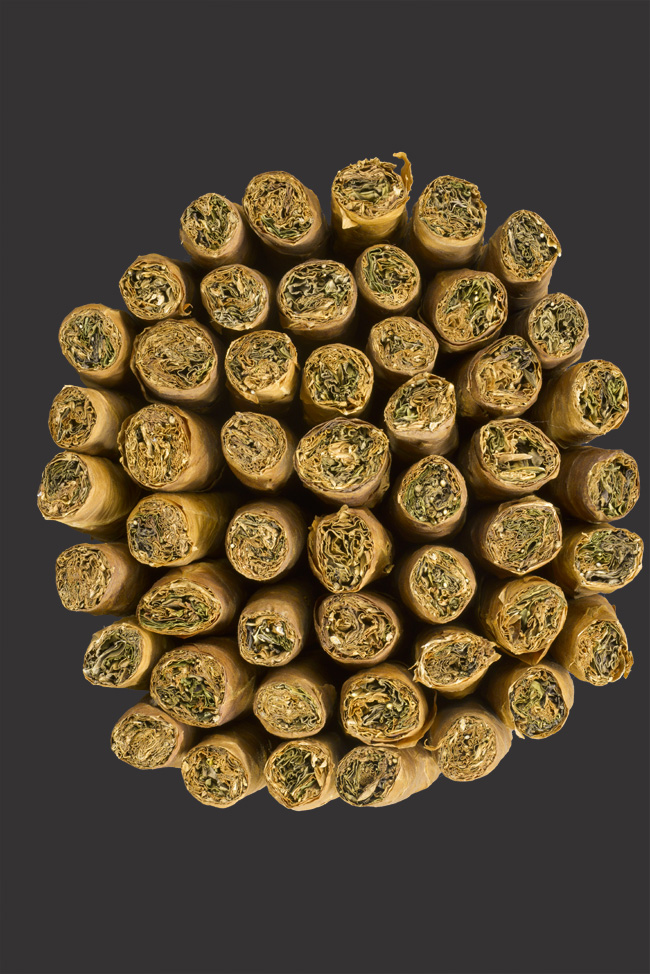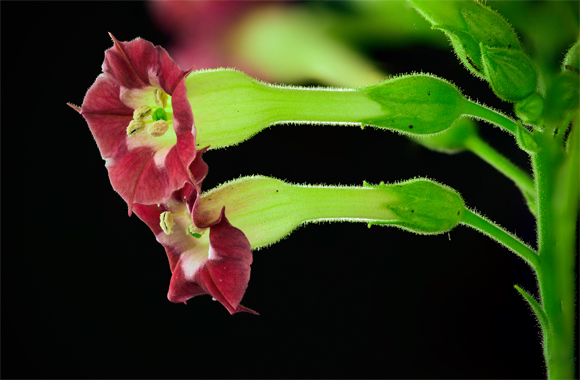Studies on what plants, besides tobacco, were smoked by Maya and Aztec
Until this year (2013) I did not realize that cacao was a major ingredient in smoking tobacco around the world today. One of the major brands of cigarettes today is flavored with cacao. As I did further research I discovered a diverse range of even more spices and flavoring which were used for tobacco by the Aztec and Maya.
We are actively seeking to find where each plant grows in Mesoamerica so we can photograph the plant and its flowers with high-resolution digital cameras. Tobacco itself is also of interest to our research, since it was a major utilitarian plant of all pre-Columbian cultures. Our research has two facets: field trips to find the plants and photograph them; and library research.
Fortunately tobacco is easy to grow, at most altitudes within Mesoamerica. Tobacco thrives in our garden of Mayan ethnobotanical plants at an elevation of 1500 meters. Tobacco also is commonly grown near the dry Motagua River area of Guatemala (but has to be irrigated in that eco-system). A major tobacco growing area in the past was around Copan Ruinas.
 |
Handwrapped cigars are readily available in most local markets in Guatemala. Cigars made for shamans may have several ingredients in addition to tobacco leaves. Most cigars today come from modern tobacco varieties grown in the Zacapa area of Guatemala. |
 |
Photograph of dark reddish color variant of Mayan tobacco flower, Guatemala. |
 |
Pink colored Mayan Nicotiana flower from Senahu garden, Alta Verapaz, Highland Guatemala; medicinal tobacco in Q�eqchi� Mayan garden. |
 |
Tobacco plants with white flowers are common in Guatemalan gardens. |
Bibliography on tobacco, pipes, and cigars of the Maya and Aztec
The list of books and articles which follows is the start of a bibliography on smoking in pre-Columbian Mesoamerica. Since we are also working on bibliographies for all the dozen flavorings and ingredients of prehispanic cigars, we will be offering (in coming months) detailed bibliographies on each plant. In the meantime, here are a few introductory references for tobacco and smoking.
- 1977
- An Ethnobotanical Investigation of Calea Zacatechichi. Thesis, Harvard University, Department of Anthropology. 48 pages.
For a Harvard thesis I would expect that the bibliography alone would be 48 pages, and the illustrations alone would be a dozen pages. But 48 pages of helpful information is better than nothing.
- 2001
- Tobacco. Chapter 2, in Proper Food of the Gods. On-line.
- 2007
- Tobacco in History: the cultures of dependence. (reprint edition) Taylor & Francis. 292 pages.
- 2010
- The Angel in the Gourd Ritual, Therapeutic, and Protective Uses of Tobacco (Nicotiana tabacum) among the Tzeltal and Tzotzil Maya of Chiapas, Mexico. Journal of Ethnobiology 30(1): 5�30. Spring/Summer 2010.
Excellent discussion: both informative and well written. What is totally different is the clear lack of ingredients other than tobacco other than slaked limestone, as an alkalizing agent. Yet�Psychotropia (one of the web sites which is relatively realistic with quotations) states that: The Mam and Tzeltal Indians smoke wild tobacco together with fly agaric skins (Amanita muscaria) for divinatory purposes.
In Guatemala today, anyone who has been a chiclero or who has worked with chicleros is aware that they smoke Guarumo leaves when they run out of tobacco.
- 1970
- Nightshades: The Paradoxical Plants. W. H. Feeman & Co., Ltd. 200 pages.
- 1987
- The Fascinating World of the Nightshades: Tobacco, Mandrake, Potato, Tomato, Pepper, Eggplant, Etc. Dover. 224 pages.
- 2008
- Sacred Gifts, Profane Pleasures: A History of Tobacco and Chocolate in the Atlantic World. Cornell University Press.
- 2008
- Sacred Gifts, Profane Pleasures: A History of Tobacco and Chocolate in the Atlantic World. Cornell University Press.
- 1934
- Chan Kom: A Maya Village. Publication 448, Carnegie Institute of Washington. Washington DC.
- 1979
- Smoking Gods: Tobacco in Maya art, history, and Religion. University of Oklahoma Press. Norman, OK. 258 pages.
This book has the most illustrations of Mayan archaeological artifacts which show the Mayan-speaking people of the 6th to 15th centuries happily smoking tobacco cigars and pipes.
- 1946
- Some Uses of Tobacco among the Maya. Notes on Middle American Archaeology and Ethnology, No. 61. Carnegie Institution of Washington.
- 1990
- Maya History and Religion. University of Oklahoma Press.
The chapter in this book (Chapter 4, pages 103-123) is an update of his 1946 notes, with some additions from Muriel Porter (1948). Unfortunately he missed more than half of the ingredients or flavoring for tobacco.
- 2009
- Garden of Eden: The Shamanic Use of Psychoactive Flora and Fauna, and the Study of Consciousness.
- 1947
- La pipa en M�xico precortesiano. Tesis para el grado de maestra.
- 1948
- Pipas precortesianas. Acta anthropologica, III, 139-152.
Most recently updated July 4, 2015, including adding a photograph of pink tobacco flowers and white tobacco flowers.
This page on tobacco, pipes, and cigars of the Maya and Aztec posted May 21, 2013